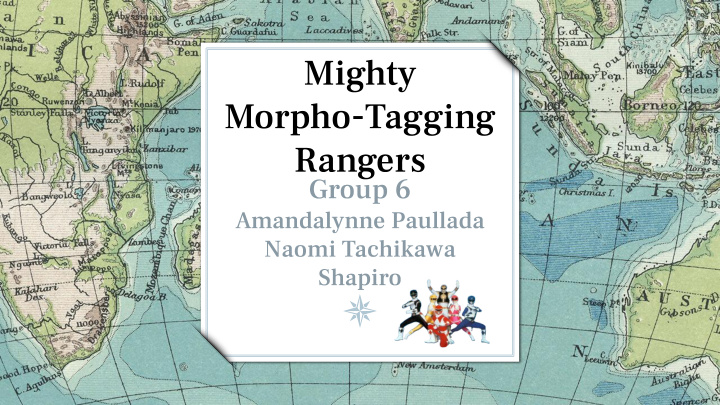



in Proceedings of NAACL-HLT 2019
Background It's hard to make crosslinguistic comparisons of RNN syntactic ❖ performance (e.g., on subject-verb agreement prediction) Languages differ in multiple typological properties ➢ Cannot hold training data constant across languages ➢ Proposal: generate synthetic data to devise a controlled experimental paradigm for studying the interaction of the inductive bias of a neural architecture with particular typological properties.
Setup Data: English Penn Treebank sentences converted to Universal ❖ Dependencies scheme Example of a dependency parse tree
ONE in Proceedings of NAACL-HLT 2019
Setup Identify all verb arguments with nsubj, nsubjpass, dobj and record ❖ plurality ( HOW? manually? ) Example of a dependency parse tree
Setup Generate synthetic data by appending novel morphemes to the ❖ verb arguments identified to inflect them for argument role and number
Setup Generate synthetic data by appending novel morphemes to the ❖ verb arguments identified to inflect them for argument role and number No explanation or motivation given for how the novel morphemes were developed, nor an explicit mention that they're novel! Might length matter?
Typological properties Does jointly predicting object and subject plurality improve overall ❖ performance? Generate data with polypersonal agreement ➢ Do RNNs have inductive biases favoring certain word orders over ❖ others? Generate data with different word orders ➢ Does overt case marking influence agreement prediction? ❖ Generate data with different case marking systems ➢ unambiguous, syncretic, argument marking ■
Examples of synthetic data
Task Predict a verb's subject and object plurality features. ❖ Input: synthetically-inflected sentence Output: one category prediction each for subject & object subject: [singular, plural] object: [singular, plural, none] (if no object) (It's NOT CLEAR in the paper WHAT the actual prediction task is / what the actual output space is. I had to look at their actual code to guess this. >:/)
Model Bidirectional LSTM with randomly initialized embeddings ❖ so no influence on statistics of e.g. '-kar' & its ngrams in other data I guess ➢ Each word is represented as the sum of the word's embedding and ❖ its constituent character ngram (1-5) embeddings bi-LSTM representation of left and right contexts of verb fed into ❖ two independent multilayer perceptrons , one for subject prediction task, one for object prediction task The prediction target (i.e., the inflected verb) is withheld during training, so what's in its place in the input??? Nothing? or a placeholder vector? -_-
Performance was higher in subject-verb-object order (as in English) ❖ than in subject-object-verb order (as in Japanese), suggesting that RNNs have a recency bias Predicting agreement with both subject and object (polypersonal ❖ agreement) performs better than predicting each separately, suggesting that underlying syntactic knowledge transfers across the two tasks Overt morphological case makes agreement prediction ❖ significantly easier , regardless of word order.
No shade at number agreement! ❖ We're interested in predicting part-of-speech, grammatical gender, ❖ verb aspect, and more Control task paradigm is cool ❖ AP out. ❖
Introduction Old news : BERT models uses WordPiece ( WP ) tokenization! ➢ Word pieces are subword tokens (e.g., "##ing") → WP tokenization models are data-driven: → Given a training corpus, what set of D word pieces minimizes → the number of tokens in the corpus? After specifying the # of desired tokens D , a WP model is trained → to define a vocabulary of size D while greedily segmenting the training corpus into a minimal number of tokens (Wu et al. 2016; Schuster and Nakajima 2012)
BERT's multilingual vocabulary Ács (2019) focuses on BERT's cased multilingual WP vocabulary ➢ 119,547 word pieces across 104 languages → Created using the top 100 Wikipedia dumps → WP tokenization ≠ morphological segmentation; e.g., Elvégezhetitek : → El , végez , het , itek (morphemes) vs. El , ##v é , ##ge , ##zhet , ##ite , ##k (word pieces)
BERT's multilingual vocabulary ( cont'd ) 119,547 word pieces across 104 languages ➢ The first 106 pieces are reserved for special characters (e.g., PAD, UNK) ➢ 36.5% of the vocabulary are continuation pieces (e.g., "##ing") ➢ Every character is included as both a standalone word piece (e.g., " な ") and ➢ as a continuation word piece (e.g., "## な "). The alphabet consists of 9,997, contributing 19,994 pieces → The rest are multi-character word pieces of various lengths... ➢
The 20 longest word pieces
The land of Unicode A word piece is said to belong to a Unicode category if all of its characters fall into that category or are digits.
Tokenizing Universal Dependency (UD) treebanks UD provides treebanks for 70 languages that are annotated for ➢ morphosyntactic information, dependencies, and more 54 of the languages overlap with multilingual BERT → Nota bene : UD treebanks differ in their cross-linguistic tokenization → schemes Ács (2019) tokenized each of the 54 treebanks with HuggingFace's ➢ BertTokenizer
Fertility Let fertility equal the number of word pieces corresponding to a single word-level token. E.g., ["fail", "##ing"] has a fertility of 2.
Crosslinguistic comparison of sentence and token lengths Ács (2019) also juxtaposes sentences lengths in word pieces and ➢ word-level tokens across the 54 languages: juditacs.github.io/2019/02/19/bert-tokenization-stats.html (alphabetical order) → juditacs.github.io/assets/bert_vocab/bert_sent_len_full_fertility_sorted.png (fertility order) → She also compares the distribution of token lengths across the same ➢ languages: juditacs.github.io/assets/bert_vocab/bert_token_len_full.png (alphabetical order) → juditacs.github.io/assets/bert_vocab/bert_token_len_full_fertility_sorted.png (fertility order) →
“ What are the ramifications of operating on word pieces ?
Recommend
More recommend